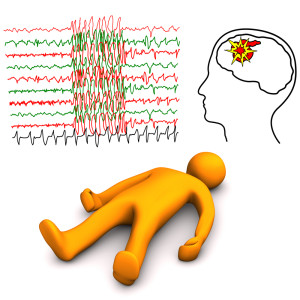Introduction
The brain is an accumulation of a myriad of nerve cells that are connected with an equal number of nerve fibers.
The communication from one end of the brain to the other end occurs via electrical signals that are generated in the nerve cells and travel through the nerve fibers at an astonishingly fast rate.
The nerve cells of the brain are also connected to the muscles, organs and skin with the help of nerve fibers that travel through the spinal cord and peripheral nerves to these end organs. Again the communication signals are transmitted through electrical impulses. Usually these signals are perfectly balanced by inhibitory nerve cells, whose job it is in the spinal cord and throughout the brain to keep these electrical signals under control.
Unfortunately some people are not so lucky. They have a “low seizure threshold” and a fever or stress can trigger a seizure. This is a state of the brain where activated parts are overruling the inhibitory parts and an epileptic seizure or partial seizure results. In the case of a grand mal seizure the person may be unconscious for a brief period of time while the muscles have shaking spells. It may start with involuntary muscle twitching around the eyes, the patient becomes unconscious and may fall down onto the ground. The patient may bite the tongue, stop breathing, shake both arms, then the trunk muscles and finally both legs.
During the seizure the patient may spontaneously urinate and/or defecate. Two to three minutes later the patient starts breathing again and the patient wakes up. Untreated the cycle would repeat itself in a few days, weeks or months depending on how seizure prone the person is. Fortunately we have learnt a lot in the past decades about seizures. There is a good classification of the various seizure types, which neurologists have developed through research and experience. New seizure medications have been developed, so that for most seizures the patient can now live a normal life and is often even allowed to drive a car. However, temporal lobe seizures are still a challenge today and more research is needed in that field. Recurrent persistent seizure activity is called epilepsy.
References:
1. F Zara et al. Am J Hum Gen 2000 May 66(5): 1552-1557.
2. S Yeung et al. Europ J Paediatr Neurol 2000; 4(1): 31-33.
3. LS Leung et al. Neurosci Biobehav Rev 2000 Sep 24(7): 763-775.
4. DJ Yen et al. Epilepsia 2000 Sep 41(9) 1162-1166.
5. E Starreveld et al. Can Fam Physician 2000 Sep 46: 1817-1823.
6. The Merck Manual, 7th edition, by M. H. Beers et al., Whitehouse Station, N.J., 1999. Chapter 172.
7. The Merck Manual, 7th edition, by M. H. Beers et al., Whitehouse Station, N.J., 1999. Chapter 271, p.2415.
8. Ferri: Ferri’s Clinical Advisor: Instant Diagnosis and Treatment, 2004 ed., Copyright © 2004 Mosby, Inc.
9. Rakel: Conn’s Current Therapy 2004, 56th ed., Copyright © 2004 Elsevier







